|
In 1987, Florida
bucked a national trend by passing legislation based on the
principle that the great majority of the citizenry should be
able to obtain a license to carry concealed weapons.
There would be no requirement to demonstrate special
need, celebrity status or political connection.
The applicant, upon demonstrating basic firearms
capability and knowledge, would receive a license unless the
State could prove ineligibility due to criminal behavior or
diminished capacity. At that time, less than ten states had this
type of “Shall Issue” laws on the books and the great
majority of states prohibited concealed carry altogether.
That same year, a
concealed handgun bill was laughed off the floor of the Texas
legislature. The major media outlets treated the entire idea as
a joke. Eight years
later, the smiles froze, the Democrat governor was history and
the Texas Right to Carry bill was law.
By 1995-6, the domino effect was in full swing with
numerous other states following with initial legislation or
shall-issue reform. In no small part, the rapid spread of Shall
Issue States was fueled by heartland reaction to the election of
Bill Clinton and his success with anti-gun legislation. By late
2003, the number of States with Right -To -Carry programs has
reached the mid-30s and the growth in reciprocity among the
states is almost impossible to track or even fathom.
The actual number of
current licenses is unclear. Florida reports an active license
count of just under 334,000. Texas is approaching the 237,000
mark. Several states appear to have no clear idea how many licenses
are in effect, or do not make the figures readily available.
I was able to find six state web sites with reasonably
current statistics and added up a conservative 1.1 million
active licenses among them (Texas, Florida, Tennessee, Michigan,
Alabama, California-restricted issue 38,000?) . While the
overall number of active licenses is obscure, it is evident that
the growth rate is profound.
*In 2003, Florida
has reciprocal license recognition with 23 States. Texas
Reciprocity covers eight states. Several states afford full
faith and credit to out of state licenses regardless of
reciprocity. Alaska
has adopted the Vermont Model of Unrestricted carry.*
The Florida-type Right
to Carry Laws, while they vary considerably in training
requirements and restrictions, have a number of features in
common that distinguish them from licensing laws in the more
restrictive states. Successful
applicants must have no significant criminal history, full
mental capacity and freedom from any evidence of chemical
dependency. Training
programs are designed to assure basic knowledge of applicable
laws and the capacity to safely handle firearms.
*In
2001, 35,070 unlicensed Texans were convicted of major and/or
gun related crimes. In the same period there were 180
convictions among Concealed Handgun License holders*
The Texas program is
not atypical. Instructors,
depending upon prior credentials, receive twenty-six to forty
hours of training for a lesson plan that includes teaching
methods, applicable weapons laws, the legalities of use of
force, safe handling and storage and basic marksmanship.
Considerable emphasis is placed upon non-aggressive
dispute mediation, interaction with law enforcement, and child
safety issues. The course takes a minimum of 10 hours and
follows a curriculum guide developed by the Texas Department of
Public Safety Concealed Handgun Licensing Bureau.
The prospective
licensee may expect to complete a standard application, submit
affidavits affirming understanding of relevant laws; allowing
contacts for a background check; and a checklist affirming
specific aspects of eligibility.
Two color passport pictures are necessary as are two
fingerprint cards (State and FBI) .
Many instructors are now set up to notarize, take the
photographs and prints but if they are obtained outside of the
training, the entire process takes about twenty minutes
excluding driving time.
The shooting
demonstration is a minimal law-enforcement model with timed fire
at three, seven and fifteen yards.
If the shooter is familiar with the mechanics of his
firearm, the course of fire is undemanding.
An unrestricted
license requires shooting the course with a semi-automatic
pistol of .32 caliber or above.
Those who choose to qualify with a revolver are then
restricted to carrying a non-semi-auto.
The fifty question
final exam is more an affirmative review of the material than a
barrier to passing the course
Between January 1,
1996 and January 1, 1997, approximately 65,000 Texans obtained
licenses with the number reaching 101,000 by October 1997.
The first wave of applicants consisted of a large number
of handgun enthusiasts, competitors and outdoors people with
most of the participating women (17- 20%) taking certification
classes with their husbands.
These trends continued in later years but the numbers of
non-recreational enthusiasts and single women increased over
time. The same is true of ethnic minorities. The first
statistical reports in Texas revealed that the number of
licensees increased steadily from age 21 through age 48 with 48
being the modal age of license holders.
In 2003 the modal age is 56, representing a substantial
increase from the same age group
(7,773). Other
states show a slightly younger licensed population but it is
evident that the great majority of license holders are 40 +
years of age.
  
Age Distribution
Texas Concealed Handgun Licensees –Late 2003
|
Age 21-29
|
15,762
|
|
Age 30-39
|
32,628
|
|
Age 40-49
|
50442
|
|
Age 50-59
|
64532
|
|
Age 60-69
|
46,719
|
|
Age 70-79
|
22,862
|
|
Age 80-89
|
3749
|
|
Age 90-100 (1
license)
|
115
|
Extrapolated from
Texas CHL Statistics 236,809
  
Age Distribution
Florida Concealed Handgun Licensees
|
Age 21-35
|
78,353
|
|
Age 36-50
|
119,721
|
|
Age 51-65
|
91,401
|
|
Age 65 –up
|
36,376
|
From Florida
Handgun license statistical abstract, mid-2003 325,851
  
Age Distribution
Arizona Licenses June 2003
|
Age 21-29
|
5482
|
|
Age 30-39
|
10794
|
|
Age 40-49
|
14912
|
|
Age 50-59
|
18389
|
|
Age 60-69
|
13064
|
From AZ
Department of Public Safety
(female licensees = 19.5%)
  
Racial / Ethnic
Makeup of Texas Licenses 1997/2003
|
White &
Hispanic
|
Female
39,333 |
Male
175,247 |
Total
Oct. 1997
94.6%
214,580
90.58%
|
|
African-American
|
2,095 |
10,096 |
Oct 1997 -
2.7%
12,191 - 5.14%
|
|
Other/unknown
|
726 |
4453 |
Oct 1997 -
1.18%
5,179 - 2.18%
|
|
Asian /
Pacific Islander
|
423 |
2,888 |
Oct 1997
- 1.4%
3,301
- 0.24%
|
|
Multi-Racial
|
166 |
794 |
Oct 1997 - 0.24%
960
- 0.41%
|
|
American
Indian
|
138 |
558 |
Oct 1997 - 0.23%
696 - 0.29%
|
African-American
participation has steadily increased from just under 3% to 5.14%
by late 2003.
  
Arizona
- Current Active Licenses and Actions since 1994
|
Arizona June
2003
|
Active
|
Suspended
|
Revoked
|
Unresolved
|
Returned
|
|
Permits
|
67689
|
725
|
670
|
51
|
825
|
|
Instructors
|
1208
|
156
|
26
|
0
|
18
|
Arizona
Department of Public Safety
  
Texas –Current
Active Licenses and Actions since 1996
|
Active
Licenses
236,907
|
Denied 1996
–03
4655
|
Revoked
2577
|
Suspended
1194
|
|
Instructors
Trained
3702
|
Instructors
2003
1411
|
Revoked 53
Denied 35
|
Suspended
11
|
  
Tennessee
–Current Active Licenses and Actions since
Inception
|
Active
Licenses
17,151
|
Denied 1996
–03
355
|
Revoked
91
|
Suspended
141
|
Tennessee
Concealed Handgun Authority
  
Trends and
Tribulations
Such statistics as are
available and reasonably trustworthy indicate that the
proliferation of legally armed citizens either reduces violent
person-on-person crime or, at the very least, has no negative
effect on the crime and accident rate.
Nevertheless, Right to Carry remains under concerted
attack by the social and political left. Positive progress is chiefly aided by the removal of
Liberal Democrats from the power structure.
The passage of the Texas CHL coincided with the election
of George Bush as Governor.
A number of appointees of the previous governor attempted
to weaken the law and were put in their place by a conservative
and eventually Republican legislature. The director of the Texas Alcoholic Beverage agency attempted
to rule that licensees committed a felony by carrying in any
establishment that sold beer, wine and liquor.
The legislature rejoined by clearly stating that the
intent was that the prohibition is specific to bars and open
saloons; that liquor store proprietors are authorized to carry
weapons.
The state Attorney
General ruled that city, county and state agencies could post
public buildings against concealed handgun licensees.
In 2003, the legislature revoked this authority.
·
From 1996-2003, No concealed handgun licensees
were arrested for Penal Code 30.06 “ Trespass By Holder of a
Concealed Handgun License.”
In 2003, Texas
legalized the unlicensed carry of handguns in recreational
vehicles (defined as vehicles containing sleeping quarters).
Alaska legalized concealed carry without the requirement
of a license.
By contrast, states
with entrenched leftist political machines are fighting an
uphill battle, both for initial passage and incremental
improvement. New
Mexico met with much opposition in the legislature and even
after a CCW law was passed and signed by the Governor, leftist
activities have managed to block implementation in the courts.
The same trend threatens the recently passed and signed
Missouri law where judges appointed by a former governor openly
subvert the state constitution.
Change is the only
predictable constant and we can’t know what direction it will
take. Nevertheless there are some encouraging trends:
Ø
The longer the concealed handgun laws are in
place, the greater the participation - and the greater the
acceptance of Right-To-Carry by the public;
Ø
About 62% of the population are in favor of
licensed, shall issue concealed carry even though the same group
supports gun registration, assault weapons bans and waiting
periods
Ø
The number of gun owner who own handguns has met
and surpassed the number who own rifles and shotguns (Gallup
poll)
Ø
The gun culture is growing and diversifying – Pink
Pistol now joins the NRA
in Second Amendment court cases. There is a slow but steady
growth in numbers and percentage of minority licensees.
Ø
There is a growing realization that an ungoverned
judicial system is exercising dictatorial authority in many
aspects of American life.
Finally, recent events
clearly demonstrate that the government cannot protect everybody
and is not particularly effective at protecting anybody at all. Such a realization does much to counteract the bombast put
forth by the enemies of individual freedom.
Mike Cumpston
  
Ed. Note:
For the latest
info on Concealed Carry (CCW) laws and state-to-state
reciprocity, click the button below to visit Packing.org.
Boge Quinn

  
Got something to say about this article? Want to agree (or
disagree) with it? Click the following link to go to the GUNBlast Feedback Page.
All content © 2003 GunBlast.com.
All rights reserved. |
|
Click pictures for a larger version.
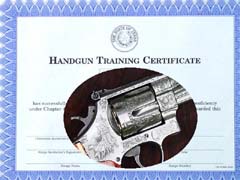
Training Certificated Revolver montage
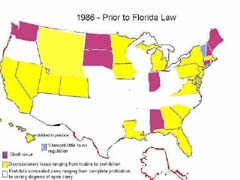
Map- Status of Shall Issue /
discretionary concealed carry licenses prior to 1987
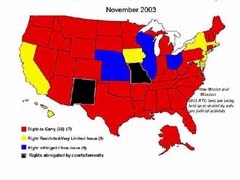
Map Status of Shall Issue/ etc license
laws in 2003
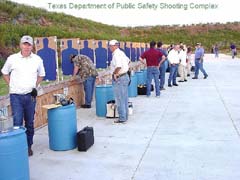
Texas Concealed Handgun Instructors must
take a refresher course and re-qualify every two years,
demonstrating proficiency with revolver and auto pistol In
September 1996, there were 2992 active instructors. By 2003,
the department had trained a total of 3702 and 1411 retained
active certification.
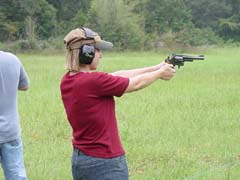
Kathryn Schmidt is an atmospheric
science major at a Texas university.
She is a superb shot with
the heavy revolvers and enjoys sport shooting with her
husband. Many Handgun licensees are recreational shooters but
a growing number are non gun enthusiasts.

Kathryn shot her proficiency
demonstration with an alloy frame Kimber .45.
She is looking at a Kahr 9mm as a potential carry gun.

Kathryn's
Kimber .45 in full recoil.
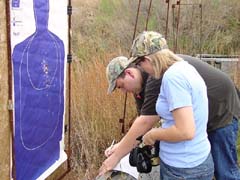
Husband Jared scores the target. Licensees must score 75% on the proficiency demonstration.
Kathryn’s score comfortably exceeds the 90% standard
required of Instructors.
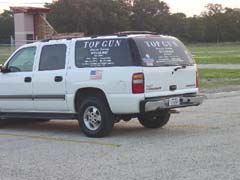
A
handgun school SUV.

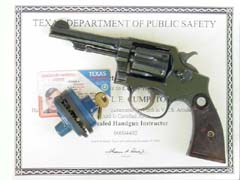
Instructors
provide the initial 10-15 hours course and the 4 hour
re-certification and review required for license renewal each
4 years.
|
![]()